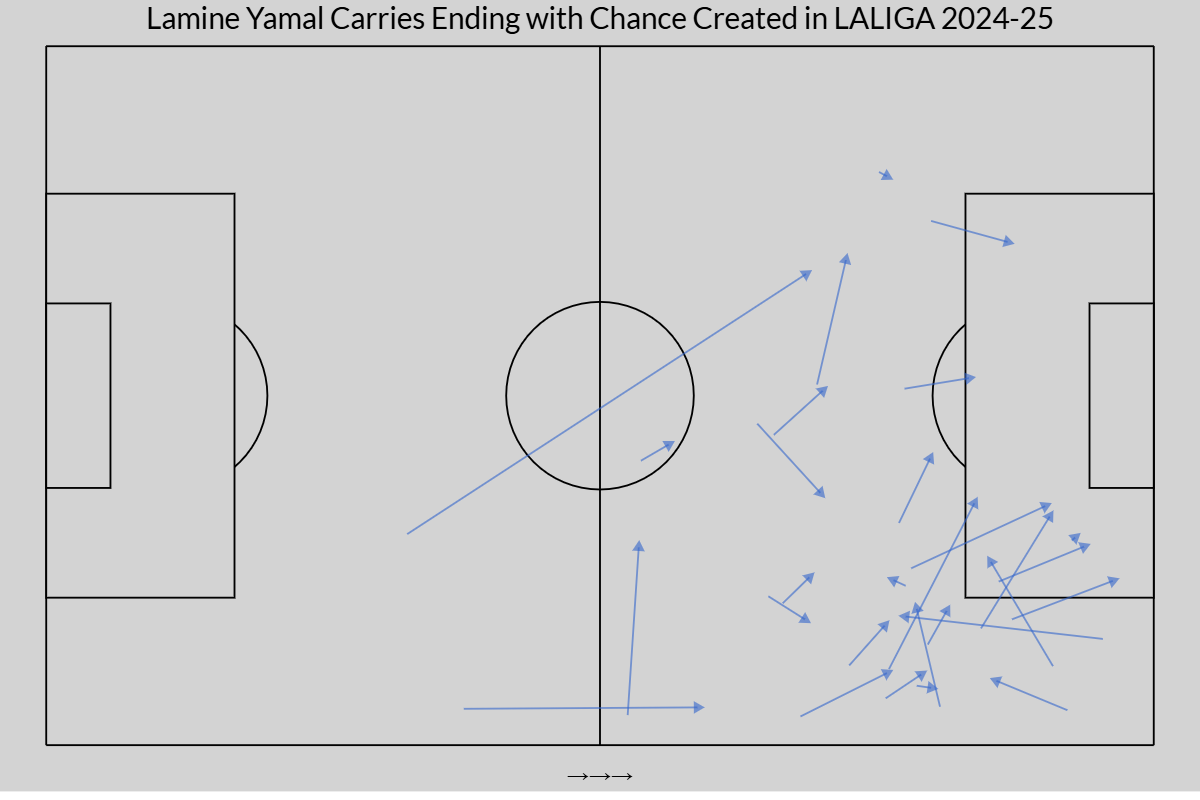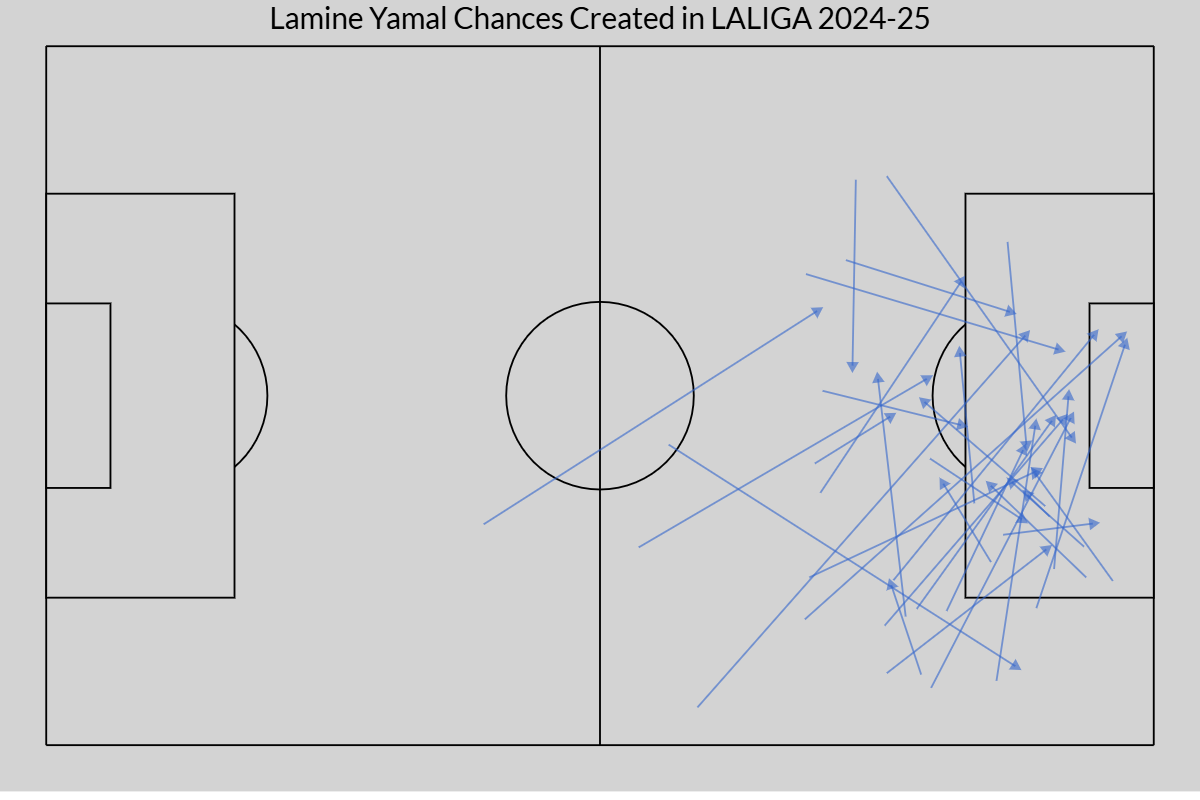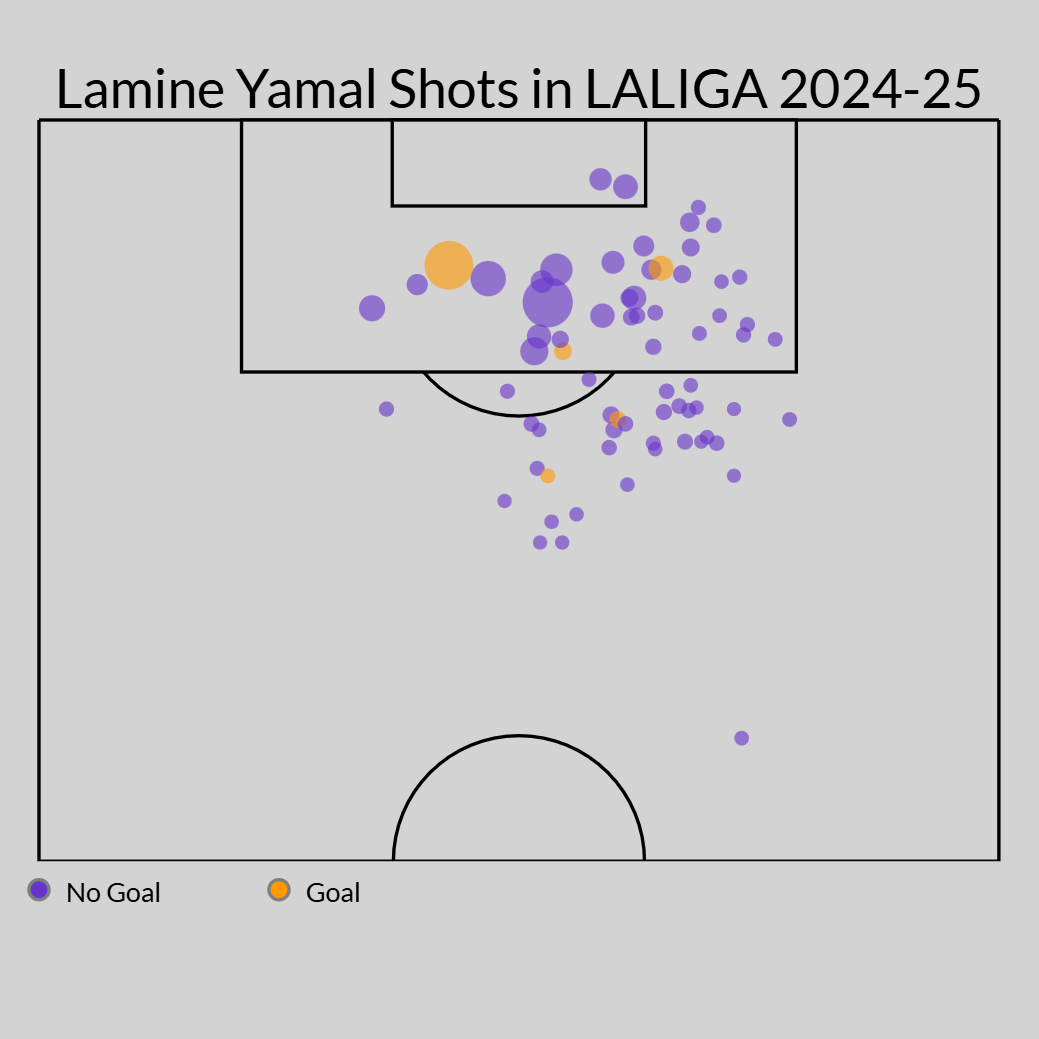Products You May Like
In the history of the beautiful game, numerous young talents have been bestowed with the phenom label. It’s a tag that carries the gravitas of becoming a defining figure of their generation. But success is never a straight line, and different factors can lead to whether a player fulfills such lofty expectations or becomes something of a cautionary tale. For every Wayne Rooney, you get a Bojan Krkić; for every Sergio Agüero, there is a Freddy Adu.
Lamine Yamal, only 17 years old, is the latest prospect to be thought of in such high regard. In his age-16 season, he was already one of the better players in LaLiga. Being a regular starter for Barcelona at 16 was an accomplishment in itself, but he was also a helpful contributor. (Stream Barcelona vs. Rayo Vallecano, Monday, 2:30 p.m. ET, ESPN+) Per FBref, among wingers and attacking midfielders during the 2023-24 season, he was in the 74th percentile for non-penalty expected goals plus assisted goals and 81st in shot creating actions (one of the two last offensive actions in the lead-up to a shot).
Following an impressive performance for Spain‘s Euro 2024 winning side, which included him winning Young Player of the Tournament, Yamal’s gone from strength to strength and when healthy, he’s arguably been one of the best players in the world this season. Among qualified players in the Big Five European leagues per FBref, a soccer stats database, as of Feb. 11 he’s in the top 25 for non-penalty goals and assists per 90 and just outside the top 20 for non-penalty expected goals and assisted goals per 90.
We’ve seen teenage footballers burst onto the scene over the years, but few at the level Yamal has shown. There’s an argument to be made at such a young age he already has a claim for being among the best at helping drive his team to victory, something very few teenagers in the history of the sport can boast.
So what makes Lamine Yamal special? How does he stack up to other teenagers of years past, and just how high is his all-time ceiling?
First, let’s look at Yamal in 2025
Yamal is the rare attacking talent who is a threat with or without the ball. With the ball at his feet, he can produce defense splitting passes or go on dazzling solo carries. Off the ball, his awareness of when to attack space is an extra asset given the quality of passers on the squad, which includes Pedri and Raphinha.
The greater focus has been on Yamal’s on-ball gifts. Despite his age, he’s already among the better creators in the sport.
Using MarkStats‘ expected threat metric, which tries to assign value to actions that precede a shot or goal, Yamal was tied for 10th in LaLiga as of Feb. 5. Across a variety of metrics from FBref such as expected assists (82nd percentile among La Liga wingers and attacking midfielders), shot-creating actions (92nd percentile) and passes into the penalty area (97th percentile), he ranks among LaLiga’s elite. This is no small feat given the caliber of wingers and 10’s in the league, such as his teammate Raphinha, Nico Williams (Athletic Club) and Vinícius Júnior (Real Madrid).
And much of it comes down to his dribbling.
Yamal’s dribbling is not necessarily built around elite speed or acceleration, either; also, he doesn’t constantly spam down the flank. He can use his first step to blow by an opponent, but his repertoire is based more around guile and anticipation. The way he receives the ball with his weaker foot can lure defenders into lunging for a tackle, which he can bypass into open space.
At his best, Yamal will enjoy sequences where he dribbles by multiple opponents. These skills also help him when trying to carry the ball from deeper areas. He’ll show displays of absorbing contact and riding challenges in these situations.

Yamal is already an advanced playmaker, blending his ability to beat people off the dribble with his impressive touch. He can generate through-balls in behind, lobs over the top, reverse passes and quick-hitting passes to teammates making underlapping runs towards the box. He’s already shown he can use advanced manipulation to fool defenders so that passing lanes open for runners in the attacking third. He’s not always successful, but being able to do all of this from typically out wide brings immense value.

So, early in his career, Yamal already has a couple of signature passes in his repertoire. One of them is the trivela, or outside-of-the-foot pass. He’ll regularly attempt one from either the right channel or out wide and from varying distances and game situations, including transition opportunities. The consistency he has with the touch on those deliveries is top-notch, and it’s been used to help swing games. He connected on it twice vs. Mallorca in the second half on Dec. 3, turning a close match into a comfortable 5-1 away win.
The other pass in Yamal’s locker are those short-range crosses from just outside the box. When defenders give him too much time on the ball, he’s able to pick out a sweet spot of space between the defensive line and goalkeeper inside the penalty area. This can lead to high value chances, which we’ve seen numerous times at the club level and for the Spanish national team. Two of his four assists were from those delicate deliveries into tight areas in the box that left the keepers helpless.
As more and more wingers in the modern game are tasked with providing width and beating low-block defenses with their on-ball skills, this can lead to them contributing minimally through off-ball movement. Yamal avoids that in part because he has some license to drift in-field, toward goal, whenever Barcelona full-back Jules Koundé occupies the flank. He’ll actively look for quick passing combos to get inside and shows a knack for making quick forward movements as the extra man around goal. Sometimes, when in the channel and center-forward Robert Lewandowski drops deep, Yamal will try to make coordinated runs into vacated space.
Yamal’s top speed — he hit 19.8 miles/hour (31.8 km/hour) in this season’s UEFA Champions League — is high enough that he’s a threat to make runs in behind high defensive lines, whether curling infield from the wings, making a straight dash within the right channel or playing on the blind side of the last defender. The goal he scored vs. Real Madrid in the Supercopa de España was an example of all these skills blending together: third-man run in behind, ability to glide past opponents around the box with a change of tempo and expert shot placement with a low corner finish.
The result of these skills is a shot map that’s varied in terms of where he attempts them. There are some that are self-created, typically from outside the box in the right channel, while there are situations where generating 4-5% quality of shots can have worth, but having too many of them can be a problem.
Mixed in are some high value opportunities from off-ball movement and counterattacks. Overall, it’s not the most efficient shot diet, as shown by his xG/shot being below 10% in league play. Unless Yamal emerges to be the kind of finisher who can constantly overperform his expected goal totals, he could stand to be a bit more efficient in this department.

Let’s compare him to previous prospects of a similar age
One can make a credible argument that not only is Yamal an elite prospect, but he’s one of the best the game has seen in a long time. He is the rare example of a player who is a major contributor today while still having massive upside for the future. This is important to note since most players his age don’t end up being good enough to play for a top European club. Rather, they end up moving at least a level or two below in the football pyramid.
Compared to other prospects about his age, Yamal’s output stacks up really well. Just this season alone, Yamal is third in non-penalty expected goals plus assisted goals among players in their age-19 season or younger with at least 450 league minutes played within the Big Five European leagues. It’s important to note that the two guys ahead of him, Orri Steinn Óskarsson and George Ilenikhena, have logged nearly 1,000 fewer minutes than Yamal. Using Stathead’s database, which has advanced stats for the Big Five European leagues dating to the 2017-18 season, the Barcelona star ranks seventh in the same metric for those with at least 1,000 league minutes played.
We can also look at how Yamal ranks with teenage talents of previous eras simply through goals and assists. Among players in their age-18 season or younger who played at least 1,000 minutes from the 1999-2000 season to now, Yamal is ninth in goals and assists per 90. If you expand it to players in their age-19 season or younger, he’s just inside the top 20 at 19th.
Among the full top 25, you can find a solid number of players who became or are among the best players in the world. The list includes heralded names from the past like Lionel Messi and Samuel Eto’o, along with current gems like Kylian Mbappé, Florian Wirtz and Jamal Musiala. It’s not without its duds, of course, but by and large this level of performance gives you a decent chance of being a special player.
So where does Yamal go from here?
It’s hard not to get excited about Yamal as a prospect. It’s one thing to see a 17-year-old play at a solid level for an upper-tier club, which does happen (recent examples include Raheem Sterling, Christian Pulisic, and Désiré Doué). It’s another thing entirely to be as good as Yamal has been to the extent that he’s single-handedly taken over games. He’s been the second-best attacker on a Barcelona side that’s got a chance (albeit slight) of completing another treble.
Efforts to create football’s version of a “game score” rank him very highly, especially compared to other young talents. Donald Cayton’s MBAPPE metric, an all-in-one metric that tries to score the player’s value towards their club’s goal differential, has Yamal 22nd for all outfield players in the major European leagues as of Feb 6th. Among U21 players, he ranks fifth.
What makes Yamal potentially an all-time level attacker is how he combines some of the traits seen from a traditional floor- and ceiling-raising talent.
A standard floor-raising talent typically describes a ball-dominant attacker who is the team’s lead decision-maker in the final third and can raise a team’s attack to solid levels despite having lesser talent around them — think someone like Bruno Fernandes at Manchester United. The ceiling-raising talent is the type of player who can help amplify others without needing the ball a ton, an immensely helpful contributor on sides with high-end on-ball creators — think someone like Pedro on those early 2010s Barcelona sides. (The late, great Om Arvind went into detail about these concepts a few years back.)
The obvious concern with Yamal, besides possible stagnation, is injuries. This season, he’s dealt with niggling issues to his thigh and ankle that have caused him to miss a handful of matches. The worry is that he might be susceptible because of the minutes load he’s had since breaking into Barcelona’s starting XI.
From 1999-2000 to now, he’s 25th in league minutes logged among outfield players through their age-18 season, and Yamal still has over a year remaining of eligibility on that list. By the end of the 2025-26 season, it’s possible he’s up there near or at the very top. This could lead to him having an aging curve where his peak is earlier than what normally happens for attacking talents.
At the trajectory Yamal is on, there’s a real chance that he could become the best player in the world at some point during his U21 years, something that’s arguably occurred only a few times over the past 30 years.
Other examples? During his age-19 season with Barcelona in 1996-97, Ronaldo Nazario scored 34 LaLiga goals and lit up Spanish football, nearly leading the club to a league title. Just over a decade later, in 2008-09, Lionel Messi was the driving force behind Barcelona’s historic treble. From 2019 to 2021, Kylian Mbappé was generating goals and assists for fun in Ligue 1, while performing at comparable levels in the Champions League and nearly leading Paris Saint-Germain to the mountaintop of European football.
In the case of Ronaldo and Mbappé, they each had multiple A/A+ level seasons by their age-21 season. Mbappé might be the closest modern comparison to Yamal. The Frenchman also burst onto the scene very early during his age 17 season in 2016-17, with an upstart Monaco side that won the Ligue 1 title and reached the semifinals of the Champions League.
Just over a year and a half into his career as a regular starter, Lamine Yamal has passed this early test with flying colors. His combination of skills has already made him one of the most impactful players in the game, putting him in rarified air for his age. His early rise to stardom, alongside the rejuvenation of Barcelona teammate Raphinha as an off-the-ball dynamo, have made them one of the best attacking duos in Europe.
Barcelona will need Yamal to be at his best over the next few months. While they have qualified for the round of 16 in the Champions League, they are on the outside looking in for the LaLiga title. Development for prospects isn’t always linear, but if things break a certain way, we could be watching the beginning stages of his ascendency to all-time greatness.
